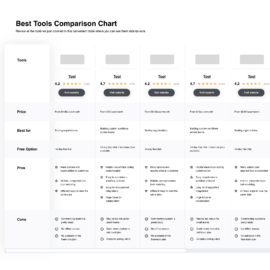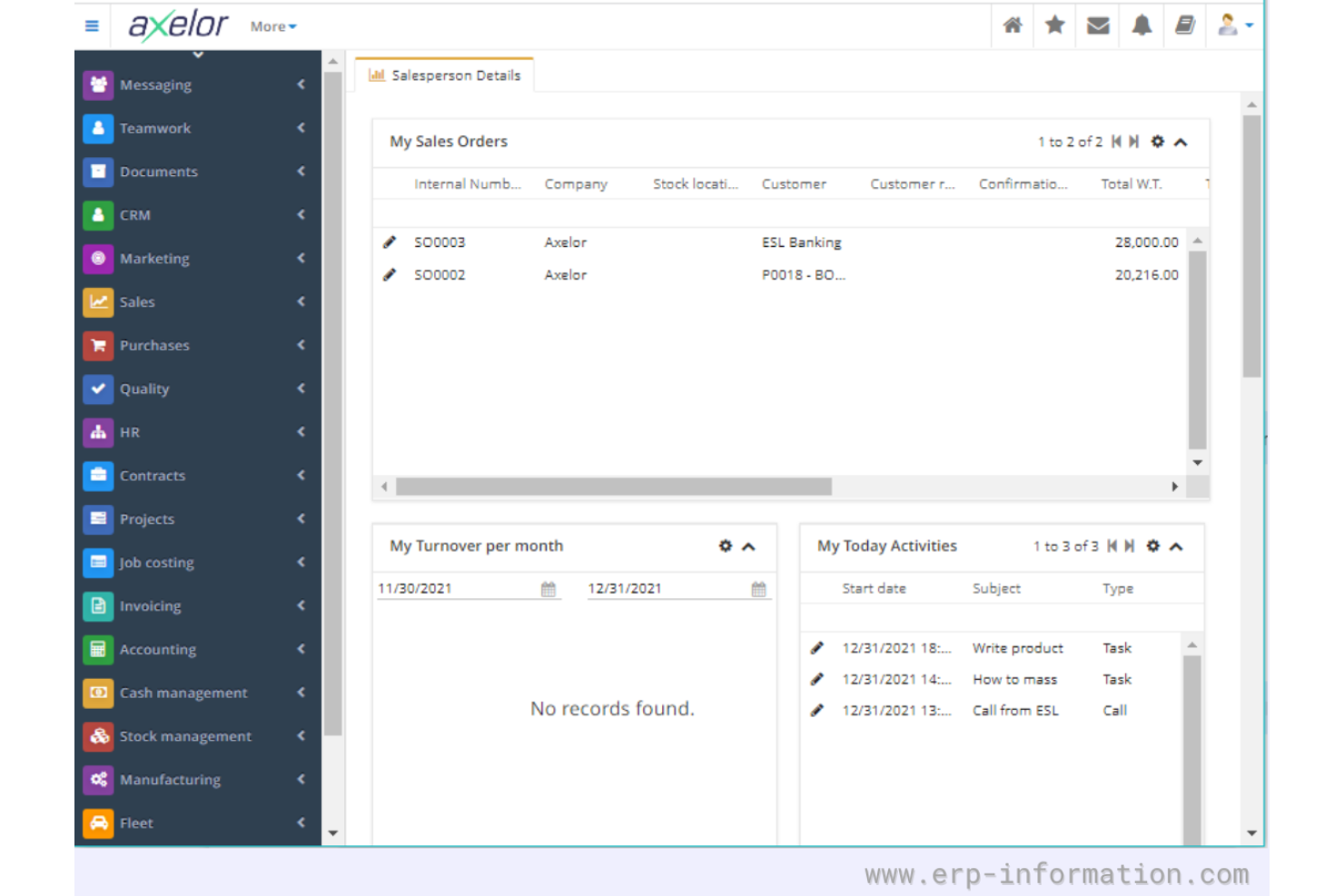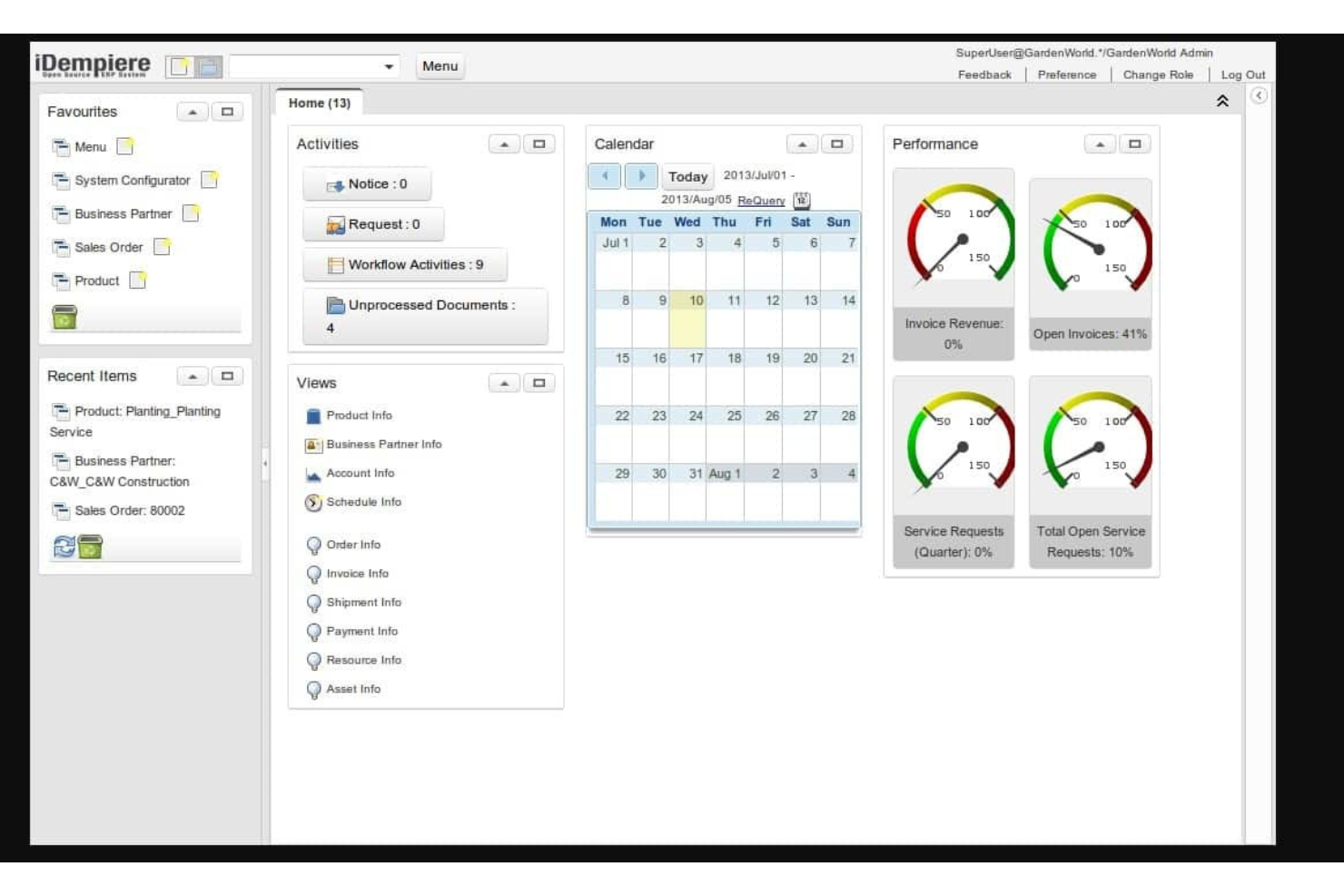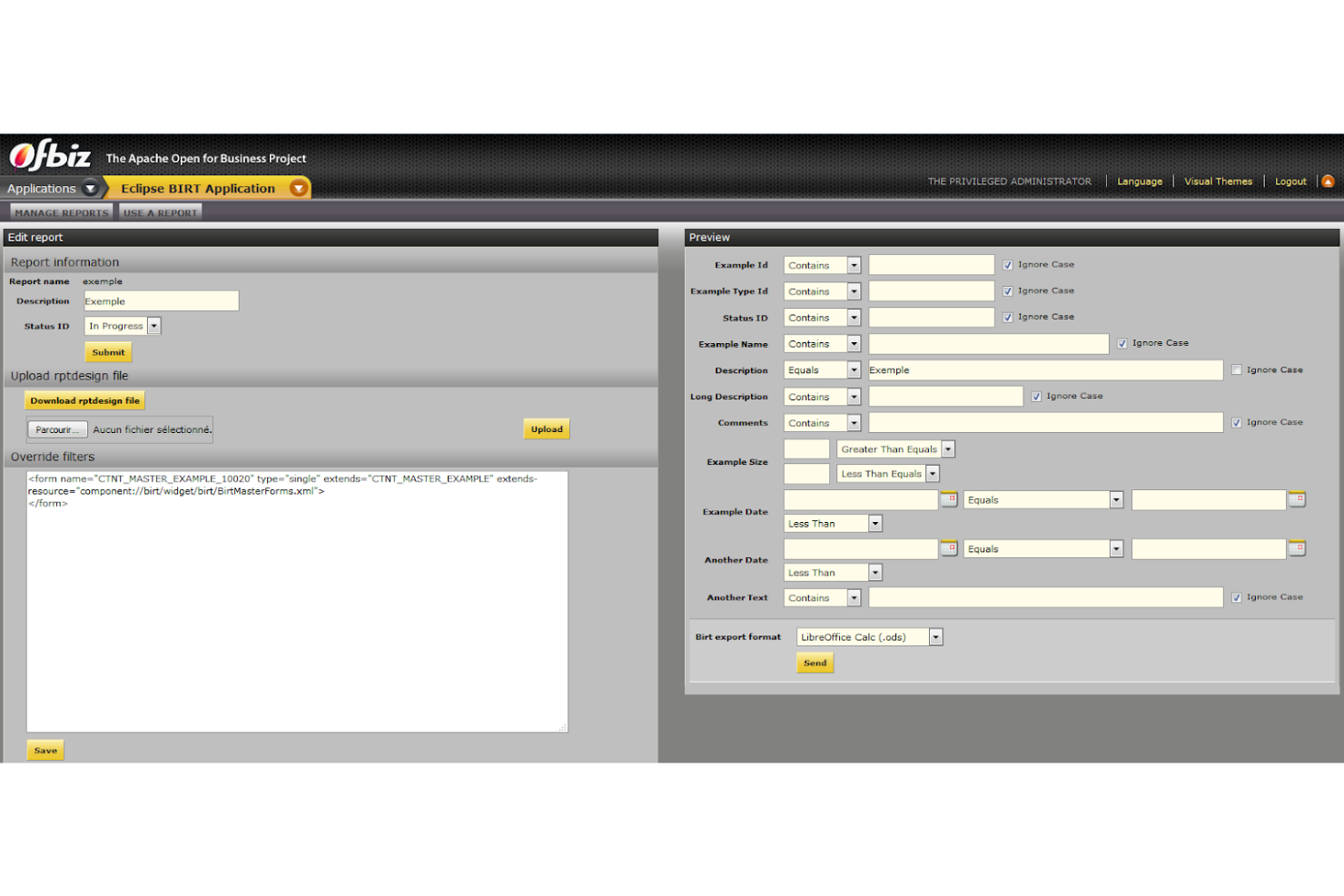Best Free ERP Software Shortlist
Here’s my pick of the 10 best software from the 18 tools reviewed.
Our one-on-one guidance will help you find the perfect fit.
Choosing the right enterprise resource planning software (ERP) is tough with so many options out there. You need to manage your business processes efficiently, but with so many options available, figuring out which tool fits best can be a challenge.
Using my extensive experience in financial management and ERP software, I tested and compared several free ERP software to help teams find the best solutions. Regardless of your business size or need requirements, I’m confident that my in-depth reviews will guide you through the software shopping process and lead you towards finding the top solution for your company.
Why Trust Our Software Reviews
We’ve been testing and reviewing ERP software since 2023. As financial operators ourselves, we know how critical and difficult it is to make the right decision when selecting software.
We invest in deep research to help our audience make better software purchasing decisions. We’ve tested more than 2,000 tools for different finance use cases and written over 1,000 comprehensive software reviews. Learn how we stay transparent & our software review methodology.
Best Free ERP Software Summary
| Tools | Price | |
|---|---|---|
| Bitrix24 | From $49/month (max of 5 users) | Website |
| Axelor | Free to use | Website |
| Dolibarr | Free to use | Website |
| ERPNext | From $50/user/month (unlimited users) | Website |
| ERP5 | Free to use | Website |
| Tryton | Free to use | Website |
| iDempiere | Free to use | Website |
| Odoo | From $24.90/user/month (billed annually) | Website |
| Apache OFBiz | Free to Use | Website |
| inoERP | Free to use | Website |

Compare Software Specs Side by Side
Use our comparison chart to review and evaluate software specs side-by-side.
Compare SoftwareHow to Choose Free ERP Software
As you work through your own unique software selection process, keep the following points in mind:
- Business Requirements: Identify the specific challenges and needs of your business to help you determine the features and functionalities the ERP software must provide. For example, a manufacturing company might need strong inventory management and production planning features, while a service-based business might prioritize CRM and project management capabilities.
- Scalability: Consider how well the ERP software can grow with your business. Free ERP solutions often come with limitations on user numbers or transaction volumes, so if your business is expected to grow quickly, ensure the software can scale up without requiring a costly data migration in the future.
- Integration Capabilities: Evaluate how well the ERP software integrates with your existing tools and systems. This is vital for maintaining operations and avoiding data silos. For example, if you use specific accounting software or CRM tools, ensure the ERP can integrate with these systems.
- User Support and Community: Make sure to assess the level of support and community engagement available for your chosen ERP software. Free ERP solutions may lack direct support, but a strong user community can be invaluable for troubleshooting and advice.
- Total Cost of Ownership: While the software itself may be free, consider the total cost of ownership, including implementation, customization, and maintenance expenses. Free ERP systems often require significant time and resources to set up and maintain, which may cost you more than expected in the long run.
When choosing free ERP software, it's essential to assess your business needs, scalability, and integration capabilities. Ultimately, the right ERP solution will streamline processes and support your business growth without financial strain.
Best Free ERP Software Reviews
This section provides an in-depth analysis and overview of my top ERP software selections that also offer free plans. Below, I will walk through each tool’s pros and cons, features, and best use cases to help you make an informed decision.
Bitrix24 is a free online workspace for businesses that offers CRM, task management, online meetings, and more. It’s best for providing an advanced suite of tools for managing sales, clients, and projects without any cost.
Why I picked Bitrix24: Bitrix24 provides users with an extensive range of features that cater to various business needs, all available for free. Unlike other tools that offer limited free options, Bitrix24 provides a full suite of functionalities, making it a standout choice for businesses looking for a cost effective solution. Additionally, the software integrates multiple essential business tools into one platform, enhancing productivity and collaboration.
Standout features & integrations:
Features include sales management, contact center, sales team collaboration, sales enablement, analytics and reports, mobile CRM, marketing, automation and integrations, task management, task tracking, API and integrations, and project management.
Integrations include tools such as WhatsApp, Instagram, Facebook, Google Analytics, Stripe, Mailchimp, Trello, Asana, Microsoft Office, and Google Drive.
Pros and cons
Pros:
- Strong CRM capabilities
- Extensive feature set
- Comprehensive free plan
Cons:
- Occasional performance issues
- Complex interface
Axelor is a low-code ERP software with an extensive application suite for diverse business needs. It allows extensive customization to meet specific business requirements, making it a versatile solution for companies of all sizes.
Why I picked Axelor: Axelor’s open source nature ensures continuous improvement and community support, providing a reliable and up-to-date solution. Unlike other ERP software, it offers a unique blend of flexibility and a wide range of integrated business applications. Its modular design offers a wide range of applications, from CRM to project management, which can be tailored to specific business needs, enhancing efficiency and adaptability.
Standout features & integrations:
Features include a low-code platform, CRM, ERP, project management, HR management, accounting, inventory, manufacturing, sales, procurement, and business process management modules.
Integrations include MySQL, PostgreSQL, Oracle, MS SQL Server, Apache Tomcat, JasperReports, Google Maps, Dropbox, LDAP, SMTP, and Active Directory.
Pros and cons
Pros:
- Low-code platform
- Extensive application suite
- Modular and customizable
Cons:
- Requires technical knowledge
- Limited community support
Dolibarr is an open source ERP and CRM web suite designed for businesses of all sizes. It’s best for flexible, all-in-one business management due to its customizable modules and advanced feature set.
Why I picked Dolibarr: Dolibarr’s flexibility and extensive range of features cater to various business needs. It stands out because it allows users to enable only the features they need, making it highly adaptable. The software integrates multiple business functions into a single platform, reducing the need for multiple software solutions.
Standout features & integrations:
Features include customer relationship management, sales, human resources, logistics, stock management, invoicing, accounting, manufacturing, marketing, foundation management, and customization through a low source code Module Builder.
Integrations include PayPal, Stripe, Google Calendar, Google Contacts, Google Drive, Dropbox, Mailchimp, WooCommerce, Prestashop, and Magento.
Pros and cons
Pros:
- Strong community support
- Comprehensive feature set
- Highly customizable
Cons:
- Requires technical knowledge for setup
- Limited native integrations
ERPNext is a free and open source cloud ERP software designed for small and medium-sized businesses. It offers a cost effective solution with no user limits, making it ideal for growing teams.
Why I picked ERPNext: ERPNext stands out as an advanced, open source ERP solution that supports unlimited users, which is rare among free ERP software. Its scalability and cost-effectiveness allow businesses to effectively grow without worrying about additional user fees.
Standout features & integrations:
Features include financial accounting, order management, HR and payroll, manufacturing, CRM, project management, helpdesk, asset management, and a fully featured website content management system.
Integrations include tools such as Google Calendar, Slack, Shopify, WooCommerce, PayPal, Stripe, Amazon, eBay, QuickBooks, and Microsoft Outlook.
Pros and cons
Pros:
- Open source
- Comprehensive modules
- Unlimited users
Cons:
- Customization complexity
- Requires technical setup
ERP5 is an advanced open source ERP system used by banks, governments, and corporations for mission-critical applications. It’s best for mission-critical applications due to its innovative Unified Business Model, which reduces configuration complexity and increases flexibility.
Why I picked ERP5: ERP5 provides advanced capabilities in handling mission-critical applications, which is a standout feature compared to other ERP systems. Its Unified Business Model makes it particularly suitable for complex and large-scale operations, ensuring reliability and flexibility.
Standout features & integrations:
Features include accounting, CRM, HR, project management, inventory management, manufacturing, e-commerce, PDM, KM, POS, and trade. It also supports predictive maintenance and optimization using machine learning and big data technologies.
Integrations include Nexedi, JIO, RenderJS, OfficeJS, NEO, SlapOS, Wendelin, Re6st, One Student One ERP, and Pyston.
Pros and cons
Pros:
- Open source
- Strong community support
- Highly customizable
Cons:
- Implementation can be costly
- Steep learning curve
Tryton is a free, modular, and scalable ERP software offering extensive business management features for various industries.
Why I picked Tryton: Tryton offers exceptional modularity and scalability, making it adaptable to various business needs. Its open-source nature and active community support distinguish it from other ERP solutions. Additionally, the active community and regular updates contribute to its robustness and continuous improvement.
Standout features & integrations:
Features include modular architecture, financial accounting, inventory management, project management, sales management, purchase management, CRM, manufacturing management, human resources, and point of sale.
Integrations include PostgreSQL, MySQL, SQLite, LDAP, Google Maps, Matomo, LibreOffice, Microsoft Office, Odoo, and OpenERP.
Pros and cons
Pros:
- Strong community support
- Scalable architecture
- Highly modular
Cons:
- Requires customization
- Limited out-of-the-box features
iDempiere is a free open source ERP software and CRM system. It’s best for businesses seeking a reliable ERP solution with strong community support, ensuring continuous improvement and collaboration.
Why I picked iDempiere: iDempiere’s strong community backing and open-source nature sets it apart from other ERP solutions. The active community of professionals and developers ensure the software remains up-to-date and high-quality. It combines state-of-the-art technology with a collaborative approach, making it a reliable and cost-effective choice.
Standout features & integrations:
Features include financial management, integrated supply chain management, flexible reporting and analytics, customizable workflows, multi-language and multi-currency support, robust security features, extensive integration capabilities, user-friendly interface, scalable architecture, and active community support.
Integrations include PostgreSQL, Oracle, Java, ZK, OSGi, Maven, JasperReports, Apache Tomcat, Eclipse, GitHub, and Jenkins.
Pros and cons
Pros:
- Cost-effective
- High-quality software
- Strong community support
Cons:
- Requires technical expertise
- Limited official support
Odoo is an advanced open source ERP and CRM software that offers a wide range of applications for various business functions. It offers an extensive suite of business apps, making it a versatile solution for businesses of all sizes.
Why I picked Odoo: Odoo provides users with an extensive range of integrated business applications, which makes it stand out from other ERP solutions. The platform's ability to cover multiple business needs, from CRM to inventory management, is unparalleled. As such, this modular structure allows businesses to start with the essentials and scale up as needed, ensuring flexibility and cost-effectiveness.
Standout features & integrations:
Features include its modular design, allowing businesses to add apps as needed, and its open source nature, which provides flexibility and customization. The platform also boasts a user-friendly interface and strong community support.
Integrations include Google Calendar, Google Drive, Microsoft Outlook, QuickBooks, PayPal, Stripe, Amazon, eBay, WooCommerce, and Shopify.
Pros and cons
Pros:
- Strong community support
- Open source flexibility
- Extensive app suite
Cons:
- Limited free features
- Complex setup
Apache OFBiz is a suite of business applications flexible enough to be used across any industry. It offers a wide range of modules and features that can be tailored to fit any business needs without the burden of licensing costs.
Why I picked Apache OFBiz: Apache OFBiz stands out as a highly flexible and customizable ERP solution. Unlike other ERP systems that may have hidden costs or limited free versions, Apache OFBiz is entirely free and open source, making it a cost effective choice for businesses. The software offers an extensive range of modules and the ability to modify and extend its features to suit specific business requirements.
Standout features & integrations:
Features include accounting, CRM, order management, e-commerce, warehousing, inventory, manufacturing, MRP, product and catalog management, promotion and pricing management, supply chain fulfillment, contracts, payments, and billing.
Integrations include Apache Tomcat, PostgreSQL, MySQL, MariaDB, Oracle Database, Google Maps, Apache Lucene, Apache FOP, Apache Velocity, and JasperReports.
Pros and cons
Pros:
- Wide range of modules
- Highly customizable
- No licensing fees
Cons:
- Limited user interface options
- Requires technical expertise
inoERP is an open source web-based enterprise management system designed to support various business processes. It’s best known for its extensive documentation, which aids users in navigating and utilizing the software effectively.
Why I picked inoERP: inoERP offers advanced documentation, which is vital for users who need detailed guidance on implementing and using ERP software. The extensive documentation makes it stand out from other open source ERP solutions, ensuring users can fully leverage its capabilities.
Standout features & integrations:
Features include a dynamic pull-based system, custom report builder, multi-device usage, and an end-to-end system with built-in CMS and collaboration tools.
Integrations include MySQL, MariaDB, Oracle 12c, GitHub, Stack Overflow, Facebook, and LinkedIn.
Pros and cons
Pros:
- Multi-device usage
- Highly customizable
- Comprehensive documentation
Cons:
- Requires technical knowledge for customization
- Complex initial setup
Other Free ERP Software
Below is a list of additional free ERP software that I shortlisted. While they didn’t make the top 10, they’re still valuable and worth further research.
- BlueSeer
Best for free ERP and EDI for manufacturing
- Scipio ERP
Best for large-scale e-commerce operations
- HubSpot
Best for CRM with marketing automation
- monday.com
Best for project management and team collaboration
- MaintainX
Best for operations and maintenance management
- OpenPro
Best for comprehensive ERP solutions
- TallyPrime 4.1
Best for accounting and financial management
- Microsoft Dynamics 365 Business Central
Best for scalable enterprise resource planning
Related ERP Software Reviews
If you still haven't found what you're looking for here, check out these tools closely related to ERP software that we've tested and evaluated.
- Accounting Software
- POS Systems
- Billing Software
- Payroll Services
- Merchant Account Services
- Inventory Management Software
Free ERP Software Selection Criteria
The criteria for choosing a free ERP software should directly address buyer needs and common pain points, ensuring that the software serves its intended purpose effectively. As an expert who has personally tried and researched these tools, here are the requirements I use when evaluating software:
Core Functionality: 25% of total weighting score
- Inventory management
- Financial accounting
- Customer relationship management
- Human resources
- Project management
Additional Standout Features: 25% of total weighting score
- Low-code platforms for customization
- Modular architecture
- Industry-specific modules
- Advanced reporting and analytics
- Mobile app support
Usability: 10% of total weighting score
- Intuitive interface
- Drag-and-drop functionality
- Customizable dashboards
- Role-based access controls
- Easy-to-navigate menus
Onboarding: 10% of total weighting score
- Availability of training videos
- Interactive product tours
- Comprehensive documentation
- Webinars and live demos
- Migration assistance
Customer Support: 10% of total weighting score
- 24/7 support availability
- Multi-channel support (chat, email, phone)
- Dedicated account managers
- Knowledge base access
- Community forums
Value For Money: 10% of total weighting score
- Transparent pricing models
- Affordable premium features
- Flexible subscription plans
- Cost-effectiveness compared to competitors
- Free trial periods
Customer Reviews: 10% of total weighting score
- Overall customer satisfaction
- Positive feedback on usability
- Praise for customer support
- High ratings for a feature set
- Consistent performance reliability
Trends for Free ERP Software
Here are some trends I’ve noticed for free ERP software technology, plus what they might mean for the future. I sourced countless product updates, press releases, and release logs to tease out the most important insights.
- Increased Focus on Low-Code Platforms: Low-code platforms allow businesses to customize their ERP systems without extensive coding knowledge. This trend is important because it democratizes access to ERP customization, making it accessible to smaller businesses.
- Integration with AI and Machine Learning: AI and machine learning integrations are becoming more common in ERP software. These technologies enhance decision-making by providing predictive analytics and automating routine tasks, thus improving efficiency.
- Enhanced Mobile Accessibility: Mobile accessibility is a growing trend, with ERP solutions offering robust mobile apps. This allows users to manage business processes on the go, increasing flexibility and responsiveness.
- Emphasis on Data Security and Privacy: Data security and privacy are paramount, with ERP systems implementing advanced security measures. This trend is vital due to the increasing amount of sensitive data managed by ERP systems.
- Adoption of Cloud-Based ERP Solutions: Cloud-based ERP solutions are gaining popularity against on-premise options due to their scalability and cost-effectiveness. This trend allows businesses to access ERP functionalities without significant upfront investments in infrastructure.
As businesses continue to seek cost effective solutions, the demand for scalable and customizable ERP systems will rise, driving innovation in the sector. Staying informed about these trends can help organizations choose solutions that not only meet their current needs but also adapt to future growth and technological advancements.
What is Free ERP Software?
Free ERP software is a tool that integrates various business processes into a unified system without the cost associated with commercial ERP solutions. Businesses of all sizes typically use free ERP software to manage operations such as accounting, inventory, human resources, and customer relationship management.
Features of Free ERP Software
When considering free ERP software, it's essential to understand the key features that can significantly impact your business operations. Here are some of the most important features to look for in free ERP software:
- Financial Management: This feature includes tools for managing payables, receivables, cash management, and revenue recognition. It helps businesses centrally manage all financial processes, ensuring accurate financial reporting and compliance.
- Accounting: Similar to standalone accounting software, ERP systems offer general ledger, cash flows, accounts receivable and payable, and expense management. Integrating accounting within an ERP system allows for better data synthesis and reporting.
- Order Processing: This feature manages the lifecycle of purchase orders from initial capture through billing, delivery, and payment. It streamlines order management by pulling information from multiple systems into one data stream.
- Project Management: ERP systems often include tools for planning, executing, and monitoring projects. Features may include task management, budgeting, cost control, and risk management, which are crucial for successful project completion.
- Embedded AI: AI capabilities in ERP systems automate tasks such as expense reporting and financial summaries. AI enhances efficiency by reducing manual intervention and speeding up processes.
- Real-Time Data: Access to real-time data allows businesses to make informed decisions quickly. It ensures data integrity and helps in spotting changing business conditions promptly.
- Automation: Automating routine business processes like order fulfillment and inventory management reduces manual effort, minimizes errors, and improves overall productivity.
- Data Analytics: Core reporting and analytics capabilities help businesses collect and analyze operational data. This feature supports decision-making by providing insights through reports, dashboards, and visualizations.
- Business Process Controls: These controls optimize and automate routine tasks, improving operational efficiency and compliance. They include workflow management, approval processes, and role-based access controls.
- Reporting: ERP systems offer various reporting capabilities, including financial, operational, and compliance reporting. These reports provide transparency and help in making data-driven decisions.
The features of free ERP software provide a solid foundation for managing various business operations, from financials and inventory to customer relationships and human resources. By leveraging these capabilities, businesses can streamline processes, improve efficiency, and maintain competitiveness without incurring high costs.
Benefits of Free ERP Software
Free ERP software offers significant advantages for users and organizations, providing essential tools for managing business operations without the high costs associated with traditional ERP solutions. Here are some of the primary benefits that potential buyers should consider:
- Cost Savings: Free ERP software eliminates the need for expensive licensing fees, allowing businesses to allocate resources to other critical areas.
- Scalability: Many free ERP solutions offer scalable modules, enabling businesses to add features as they grow without incurring additional costs.
- Customization: Free ERP platforms often come with open source capabilities, allowing businesses to tailor the software to their specific needs and workflows.
- Community Support: Users benefit from active communities of developers and users who contribute to ongoing improvements, support, and troubleshooting.
- Accessibility: Free ERP software is typically cloud-based, offering users easy access to business data and processes from anywhere with an internet connection.
Using the best ERP software allows businesses to streamline operations, improve efficiency, and reduce costs, making it an attractive option for organizations of all sizes. These benefits highlight the value and practicality of free ERP solutions in today's competitive business environment.
Costs & Pricing of Free ERP Software
For software buyers with little to no experience, understanding the costs and pricing options of free ERP software can be challenging.
However, it’s important to remember that while the software may be free, features, usage, or support may be limited compared to paid plans. Below is a table summarizing the different free ERP software options, their average prices, and common features included in each plan.
Plan Comparison Table for Free ERP Software
| Plan Option | Average Price (Per Month) | Common Features Included |
| Free plan | $0 | Basic accounting, inventory management, CRM, limited user support. |
| Basic plan | $50-$100 | Core modules like accounting, basic CRM, and inventory management. |
| Standard plan | $100-$250 | Includes advanced modules such as project management, HR, and enhanced CRM features. |
| Premium plan | $250+ | Offers comprehensive features including advanced analytics, automation, and customizations. |
| Enterprise plan | Custom pricing | Provides full access to all modules, dedicated support, and extensive customization options. |
When choosing a free ERP software, consider the specific needs of your business, the scalability of the software, and the level of technical expertise required for implementation. Each free ERP option offers a unique set of features that can cater to different business requirements.
Free ERP Software FAQs
Here are some commonly asked questions I’ve received about free ERP software.
Can free ERP software handle large-scale business operations?
Yes, many free ERP solutions are designed to scale with your business. They offer modular architectures, allowing you to add features and capabilities as your business grows.
How secure is free ERP software?
Security in free ERP software varies by provider. Many solutions implement advanced security measures, but it’s essential to evaluate each software’s specific security features and ensure they meet your business requirements.
Is technical support available for free ERP software?
Technical support availability varies. Many free ERP solutions have active user communities and forums for support, while some offer paid support plans for additional help and services.
Are there limitations to using free ERP software?
Free ERP software may have limitations in advanced features and scalability compared to paid versions. Some may also require technical expertise for customization and implementation.
How difficult is it to implement free ERP software?
Implementation difficulty depends on the software and your business needs. Some free ERP solutions offer straightforward installation processes and extensive documentation, while others may require more technical knowledge.
What’s Next?
Ready to compound your abilities as a finance professional? Subscribe to our free newsletter.




















